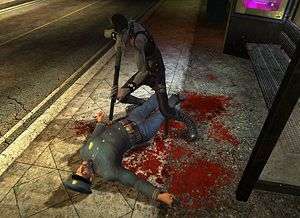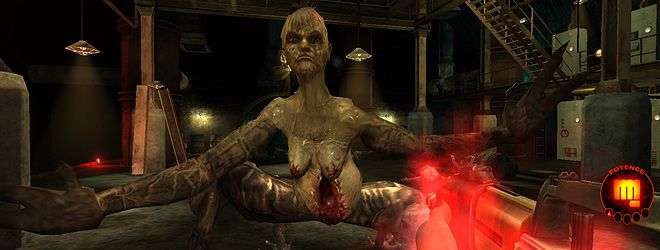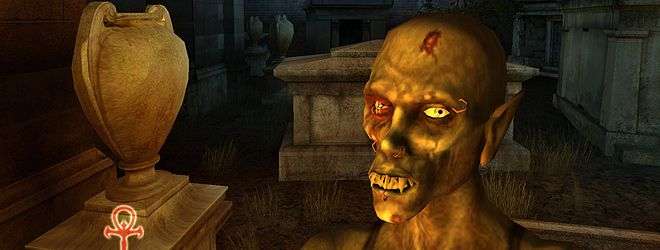Best of 2013: A Lesson in Patience. Vampire: The Masquerade – Bloodlines
by Kris
First Published: October 1, 2013
Voted For By: Chris
Reason(s) for Vote:
I personally loved this game and the article captures that love perfectly. It had so much depth for a game that was flawed in places but still hugely ambitious. Kris doesn’t shy away from the fact its been a long road to get to a point where you can fully appreciate Masquerade at its finest but still captures the real pleasure it is to exist in its universe.
————————————————————————————————————————————————————–
 Invariably referred to as a ‘cult classic’ for its poor commercial beginnings, Vampire: the Masquerade – Bloodlines was the final nail in the coffin of the fondly-remembered, chronically-overambitious Troika Games, yet it should not have been so and remains one of the greatest ‘what ifs’ of gaming history.
Invariably referred to as a ‘cult classic’ for its poor commercial beginnings, Vampire: the Masquerade – Bloodlines was the final nail in the coffin of the fondly-remembered, chronically-overambitious Troika Games, yet it should not have been so and remains one of the greatest ‘what ifs’ of gaming history.
As of September 2013, the Metacritic score for Bloodlines is 80 out of 100 from the critics (with 61 reviews) and a user score of 8.9. Most reviews praise the story, the writing, the voice acting, and the setting – Bloodlines created an awesome world, and the Ocean View Hotel level is hailed as a masterpiece of scripted gaming. Furthermore, every year there are more retrospectives (much like this one) praising and lamenting Bloodlines as equal parts diamond and rough, usually with a glut of comments reinforcing the nostalgia alongside cries to remake the game. This game no doubt has left a substantial mark on a generation of RPG gamers, to the extent where it is almost guaranteed that it will be reinstalled by someone when such an article appears.
Looking back over the history of the game’s development and release, it’s surprising that a game with such scope and so many problems actually achieved the cult classic status that it has. It began development in 2001, beset with problems: it was the first third-party game to use Valve’s Source Engine – which was not yet completed – with Troika developing their own AI to run on it, White Wolf and Activision having to vet everything, and a development team smaller than most, and especially small for the scope they were planning.
In 2004, Activision seemed to want the project over. They brought the game out as soon as was legally possible and, in the process, took the sales-killing decision to release it on the same day as Half-Life 2 (due to a contract with Valve not to release it before theirs). The original plan had been to release Bloodlines in the spring in 2005 to avoid competition with Half-Life 2, Halo 2 and Metal Gear Solid 3, yet Bloodlines was condemned to be out-competed and rushed in a release that lead writer Brian Mitsoda said “felt one step up from being sold at a yard sale.”
 The notoriously-overambitious developer was left without an assigned producer from Activision for over a year, meaning that the project went off on tangents and was allowed to bloat. The resulting crunch to meet the new release date must have been like receiving a thousand sit-ups via electrical stimulation in a single minute; a kill or cure remedy. David Mullich, the producer, described it as “a very gruelling project,” while Brian Mitsoda said that the “the worst” part of the game had been its “scope [...] burning me out for a couple of months after the project was over.” Although he did add that, as bad as that was, it was on par with “realizing that, for the rest of your career, you probably won’t get to write anything like Bloodlines.”
The notoriously-overambitious developer was left without an assigned producer from Activision for over a year, meaning that the project went off on tangents and was allowed to bloat. The resulting crunch to meet the new release date must have been like receiving a thousand sit-ups via electrical stimulation in a single minute; a kill or cure remedy. David Mullich, the producer, described it as “a very gruelling project,” while Brian Mitsoda said that the “the worst” part of the game had been its “scope [...] burning me out for a couple of months after the project was over.” Although he did add that, as bad as that was, it was on par with “realizing that, for the rest of your career, you probably won’t get to write anything like Bloodlines.”
With all these problems, the question becomes not ‘how did Bloodlines fail?’ but ‘how did it become so popular in the first instance?’ How did a game so unfinished and so overambitious secure its place in the hearts and minds of so many gamers? Because it was everything other than finished. It may not have had polish, but it had soul; an atmospheric world with great characters and voicing created the perfect feel for the game. While clearly an early commercial failure, I cannot help but feel that commercial success could have come with time as, in all these years, the reviews and popularity has not waned. Even with such glaring flaws, Bloodlines is a success. No doubt the business side of Troika Games had some faults (as Leonard Boyarsky admitted) but the decision of Activision to release Bloodlines some six months earlier than planned was brave at best.
 |
 |
 |
 |
 |
 |
 |
 |
 |
Despite poor initial sales, the game has consistently been sold and even now has a stable presence on digital distribution sites, with Steam still selling it at the inflated price of £15 ($20). It’s clear that Bloodlines created one of the most precious things in gaming – a loyal and nostalgic fanbase. The unofficial patches made by dedicated fans has hit version 8.7 this august – nine years since the game’s original release. The patches have also restored cut and unfinished content, including an entire level of the game and there is even a project underway attempting to port Bloodlines into the latest Source engine. Where else does one see this level of volunteer dedication for something so unfinished?
Bloodlines cries out for a remake, or for a game of similar scope and design to surface again. But what is the lesson of Bloodlines? It is perhaps that most people will forgive such glaring and horrific bugs if coupled with perfect atmosphere and writing. A properly-written game with strong support, such as patches and marketing, could make some serious money for the right publisher if they are willing to be patient. Bloodlines’ continued fan devotion poses a question to me: If it’s been nearly a decade since Bloodlines created such an impact, with a game that had everything except polish, why do we still get games that have the exact opposite problem?
Last five articles by Kris
- Obituary: Mordin Solus
- Best of 2013: Star Wars Galaxies Retrospective - A Community Far, Far Away
- Best of 2013: A Lesson in Patience. Vampire: The Masquerade - Bloodlines
- Star Wars Galaxies Retrospective: A Community Far, Far Away
- Total War: Rome 2 - Review





















There are no comments, yet.
Why don’t you be the first? Come on, you know you want to!